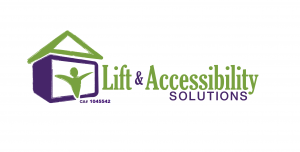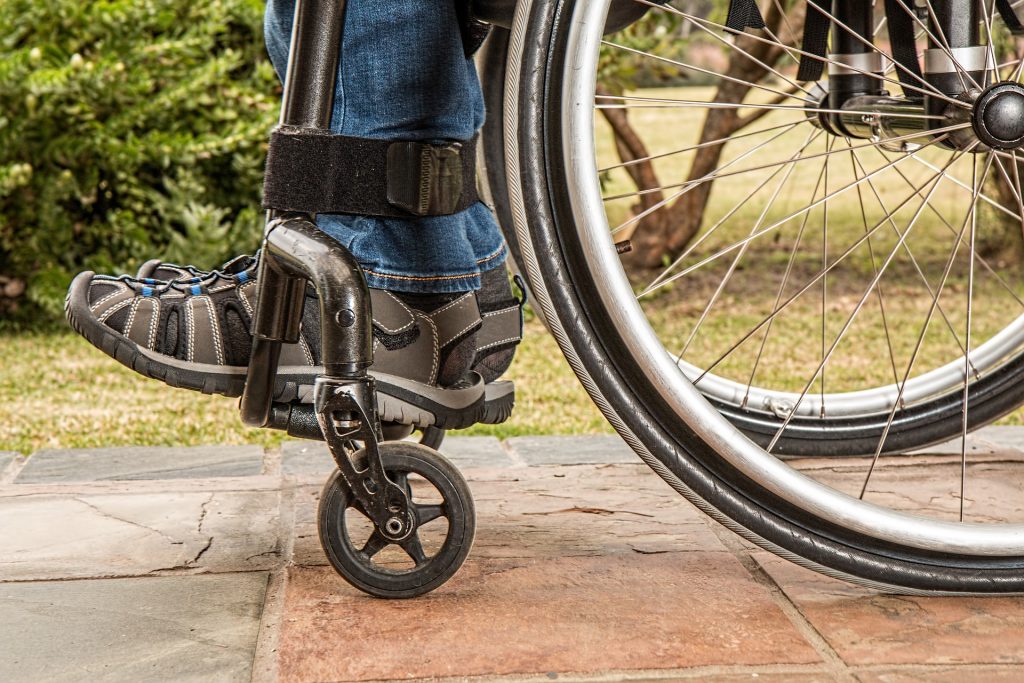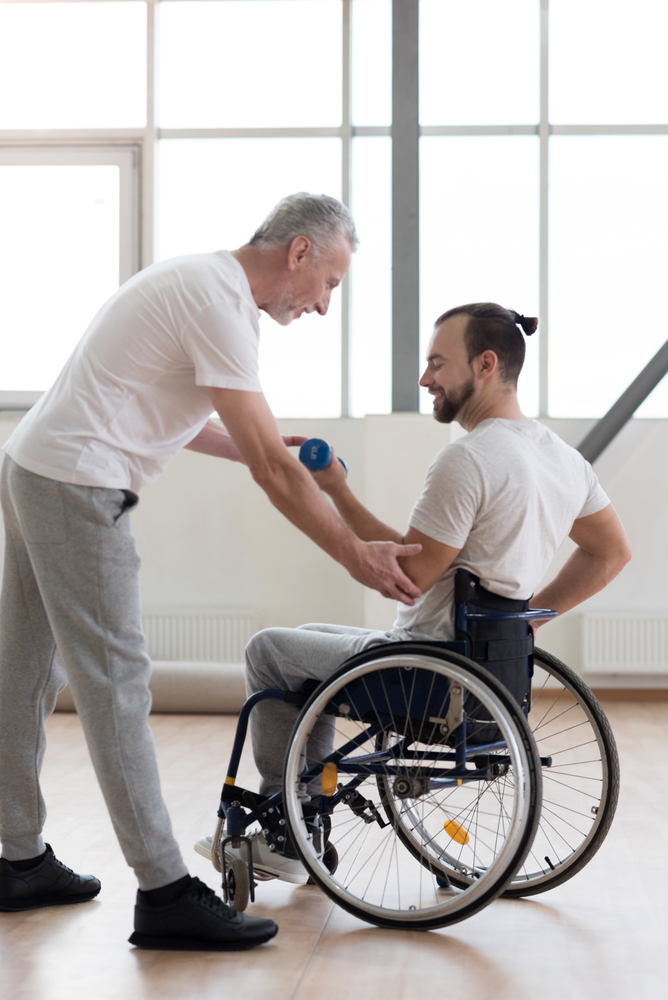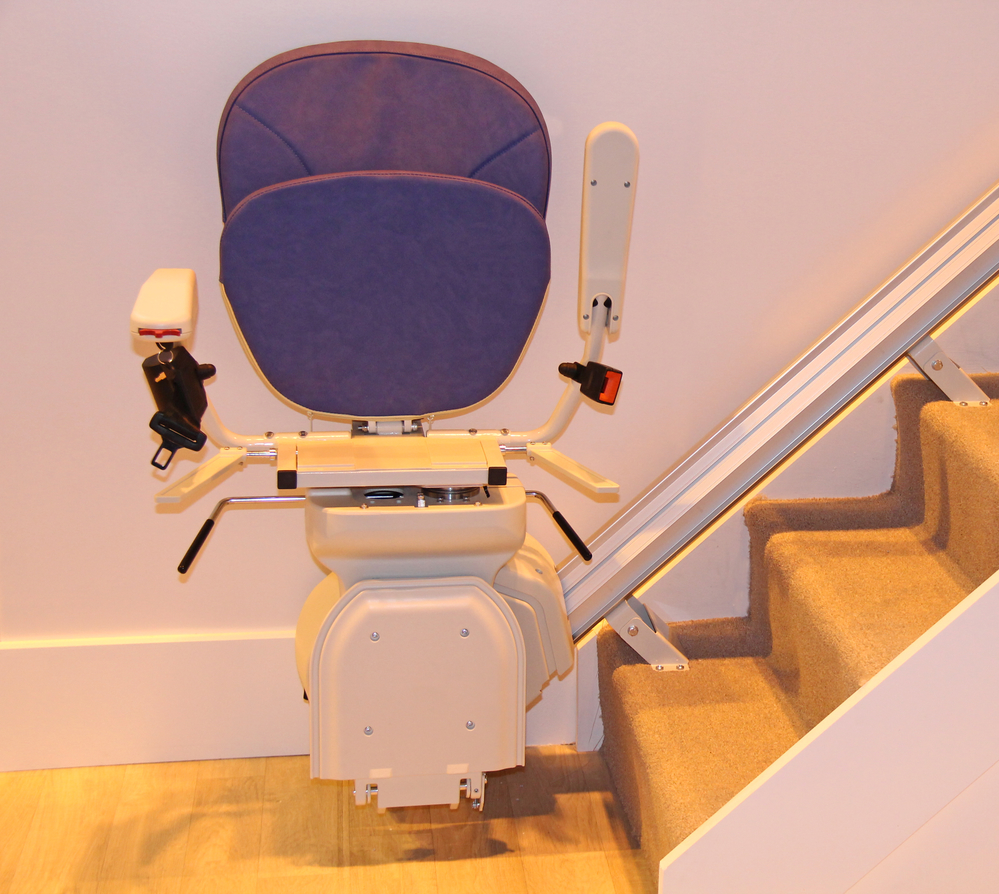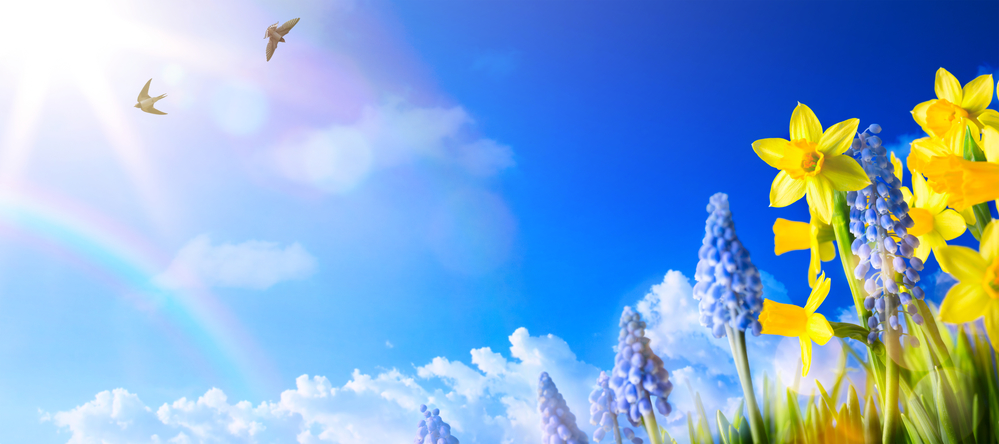14 May / 2018
Managing Weight When You Have A Disability
It’s well known that maintaining a good weight is a challenge for many people, and if you have a disability, that challenge is even greater due to decreased mobility. But it’s not impossible to maintain a healthy weight when you have a disability, you just might have to approach it slightly different from others.
Managing Weight When You Have A Disability
Burning Fat
Everyone’s body burns calories; our metabolism is responsible for that. Some people burn calories faster than others due to having a fast metabolism. Those that have a faster or slower metabolism than the average person are most commonly caused by their genetic makeup. And as we age, our metabolism slows down.
There are various ways to burn fat, some of them include the following:
– Drinking more water
– Decreasing your calorie intake
– Decreasing your sugar intake
– Eating six small meals throughout your day
– Increasing vegetable consumption
– Increasing your protein intake: helps burn calories and keeps you feeling full
– Strength training burns 10 percent more fat (consult with your physician before beginning an exercise program)
For weight loss, people with limited abilities should take in less than 2,000 calories. If you’re maintaining your weight, keep the calorie intake the same just make sure you are getting it from healthy foods.
Exercise
You should discuss your options with your physical therapist regarding an exercise routine that you can do within your limitations. Also, check into programs in your area that are geared toward your disability and whose surroundings allow you to exercise in a safe and supportive fashion.
Weights
Weight lifting is still one of the strongest fat burning techniques and is still a viable option for people with limited abilities. Check with your local gym to find out if they have an experienced trainer who can design a weight lifting program that meets your needs.
Cardio
Cardiovascular exercise raises your heart rate while lowering blood pressure thus lowering your risk of cardiovascular problems. It also aids in maintaining good muscle strength and strong joints. People who have mobility issues can find cardiovascular exercise difficult to accomplish, but it’s not impossible.
Other Options
Maintaining your balance, especially during workouts, is a big concern for people with disabilities looking to get some exercise. Consider finding a water workout class in your area, water workouts can provide support and the movements are generally paced to your ability. Water workouts can provide natural resistance to help raise your heart rate. Exercise bands are another good option, they provide a wide variety of exercise techniques suitable for people with limited abilities.
04 May / 2018
Uses for a Home Elevator you No Longer Need
If there is someone in your home who has lost mobility, it is important to modify your house to make it more accessible. One great choice for allowing someone in a wheelchair to get to every floor of the house is to install a home elevator. However, when the elevator is no longer needed, it can easily sit unused.
Your home elevator does not need to be rendered useless when you no longer need it. Instead, you can repurpose it so you can get your money’s worth from it. Below are some great ways to use your home elevator after it has finished servicing its initial purpose.
Uses for a Home Elevator you No Longer Need
Laundry and Other Heavy Loads
Laundry. Anyone who runs a household can tell you that doing laundry is a never-ending process. It often seems like as soon as the week’s laundering is done, the next week’s starts. Plus, if bedrooms are on an upper floor and the washing machine is on the first floor or basement, you need to tote heavy baskets full of clothes down at least one flight of stairs. Then, once the laundry is done, you have to reverse the process by bringing the clean clothes up. Having to complete this process regularly can be cumbersome and tiring. But, if you have a home elevator at your disposal, you can use it to help you with all of the toting. You can put all of your laundry baskets in the elevator at the same time and send them down to the laundry room. This method saves you a lot of time and effort. So, you can get your laundry done in a fraction of the time without having to struggle carrying the baskets all over the house.
You can use the home elevator to reduce trips with any heavy items.
Take the Babies Upstairs
Sleeping babies should not be disturbed. Taking a baby upstairs to his or her crib can be a tricky feat. As you traverse a flight of stairs, it is easy to jostle the baby awake. Plus, you need to either hold the baby with one hand and the railing with the other or hold the baby securely with two hands and hope to not trip up the steps. Either way you choose, you are risking the safety of both you and your baby. But, if you use a home elevator, you can safely take your sleeping baby upstairs soundly and safely without having to worry about waking your sleeping child.
If you have a home elevator that you no longer need to use, you do not need to worry about it wasting space in your home. With a little ingenuity, you can find new uses for it and still let it be a part of your everyday life. If you have questions about home elevators, contact Lift and Accessibility Solutions today.
26 Apr / 2018
How Long Does a Wheelchair Last?
A properly-working wheelchair can be a lifesaver for someone with limited mobility. So, when a wheelchair stops working, it can negatively impact a person’s life in many important ways. It helps to learn how long you can expect a wheelchair and its accompanying components to last to prevent being in this situation.
How Long Does a Wheelchair Last?
Manual Wheelchairs
Manual wheelchairs are common, and for the most part, they all look similar. But, there are definitely some differences you need to know about before you choose the best wheelchair for your needs. One of the biggest differences in manual wheelchairs is the material from which they are made.
Here are some tips to keep in mind about wheelchair construction:
- Steel chairs are cheap and strong. These chairs are mostly found as rentals in public places and are not generally sold for personal use, as they are heavy and hard to maneuver.
- Aluminum chairs are cheap and light. Aluminum chairs can get heavy over time. They also rust easily and can get brittle and crack.
- Titanium chairs are strong and light. They are built to last longer than aluminum chairs; the material is resilient and does not crack or break easily.
- Carbon fiber chairs are strong and light. These chairs are light but hard to adapt or customize. They are also quite expensive.
Manual wheelchairs made of anything by aluminum are long-lasting and reliable, but do learn about the type of wheelchair you have or are planning to buy to ensure you take care of it as needed and know how long it can feasibly last.
Power Wheelchairs
Power wheelchairs are commonly used today. Due to their mechanical nature, they are more likely to break down than manual ones are. But, with some general maintenance and care, they should last for a long time. Here are some guidelines to follow to get the most use out of your mechanical wheelchair.
Battery
A power wheelchair cannot operate if the battery does not work, so it is vital to keep it in good working order.
Here are some tips to ensure your power wheelchair battery stays functional.
- Keep it fully charged
- Only drain a new battery by 30% the first 10 days
- Charge the battery every night
- Do not deplete the battery beyond 80%
- Only use the charger that came with the wheelchair battery.
Wheelchair battery life varies and is dependent on several different factors. But, if you take good care of it, and follow the guidelines above, the battery should last for at least five years.
Servicing your power wheelchair
Your power wheelchair should be professionally serviced at least once a year. Between tune-ups, perform regular maintenance checks on your wheelchair to ensure it stays in good working order. Check for loose parts and remove any built-up dust. Also, if you use your wheelchair outside often, make sure you wipe it down after it has been in the rain or snow so it does not rust.
18 Apr / 2018
How To Get Into Adaptive Horse Back Riding
Adaptive horseback riding is a great springtime activity. The weather is turning warmer, and the flowers are in bloom, so this is a great time to be outside and take lessons.
How To Get Into Adaptive Horse Back Riding
You’ll want to make sure that you have an instructor certified by the Professional Association of Therapeutic Horsemanship International (PATH).
The instructor will tailor lessons to your individual needs by using adaptive equipment and techniques for a safe and fun lesson. An integral part of the first lesson is meeting with you and your family to determine what you’d like to achieve. Some students want to improve self-esteem while others want to improve their basic riding skills.
Adaptive Horseback Riding is Great For All Groups
Most classes will accommodate students age 4 and older. The instructor will set a pre-determined goal, then adapt the lessons to each individual in order to achieve that goal. All lessons are tailored to each student’s ability. The instructors will use exercises, games and other teaching methods, tools to reach these goals.
The motion of the human body on a horse is very much like the walking motion, so it is fantastic therapy. If you haven’t considered it, you definitely should. Not only does it have physical benefits like improved balance, posture and reflexes, it also provides emotional benefits as well. You’ll have more confidence and you’ll feel a sense of bonding between human and horse-it’s a special relationship.
We’ve seen many non-verbal students progress from being apprehensive to eagerly approaching their next lesson.
While you can take individual lessons, group lessons are even better. It’s a great way to develop social skills and even leadership. Some students love the riding lesson so much they want to learn how to care for the animals. That is definitely possible—you can learn stable management tasks like sweeping, cleaning and feeding and watering. It might even lead to a job.
Try Adaptive Horseback Riding
If you’ve felt limited in your ability to pursue recreational activities, consider adaptive riding. It is a wonderful recreational activity for people who need special equipment or special teaching methods. Many places offer both indoor and outdoor arenas, as well as horseback riding for the whole family—a great added benefit. With the adaptive program, you’ll have a certified instructor and someone who is leading or walking alongside the horse at all times to ensure the utmost safety.
So, if you’ve been looking for a new outdoor activity, there’s no better time than now to get on that horse and start your lesson today.
09 Apr / 2018
4 Weight Management Tips for Seniors
They say that as you age, your body is just not what it used to be. This can’t be more true than it is as you enter the senior years. Welcome to brittle bones, protruding middles, and watching everything begin to sag. Although aging and the signs of aging are inevitable, it is possible to stay healthy and maintain a healthy weight.
Here are a Four Weight Management Tips for Seniors
Stretch
According to the Stretch Coach, stretching is the “process of placing particular parts of the body into a position that will lengthen, or elongate, the muscles and associated soft tissues”. Have you ever noticed that getting shorter seems to be a part of the “growing old” packaged deal? It doesn’t have to be that way. Not only can stretching lengthen your body, it can also keep the blood and circulation flowing and increase your range of motion which leads to a better quality of life.
Move Your Body
Exercise is great for managing your weight. It doesn’t have to be strenuous. Consistency is more important. You can take a walk in the evening after your dinner. Swim classes are great low-impact workouts. Even regular yard work can be great for your health. Be sure to consult with your doctor before you start any exercise routine.
Eat Sensibly
It would be tempting to reduce your calories as you age, because the fat just doesn’t melt off like it used to do. Just don’t starve yourself or be too obsessed with counting calories. Make sure you are getting healthy portions of fruit, vegetables, healthy fats and healthy proteins. As you make healthier food choices, you should be able to notice that you have more energy, a clearer head, and possibly some healthy weight loss!
Get a Good Night’s Sleep
The quality of sleep you get the night before affects everything that happens the next day. It affects your mood and your cravings. Yes, if you get little to no sleep, you will crave those not so healthy sweet or salty snacks. In addition, a good night’s sleep helps keep your hormones balanced. When everything is balanced, you can more easily maintain your weight.
Weight management is tricky at any age. As a senior, you want to do your best to keep your body strong and healthy. This makes for a greater quality of life. So lace up those shoes, grab a buddy and take a walk around the block, or go walking solo. To your health!
02 Apr / 2018
How To Get Started With Adaptive Golf
Golf is a very adaptable sport, because it is more about will than ability. Golf is pretty fun. Even people who begrudgingly go with a friend to the course end up having a lot of fun once they start hitting balls around on the green. People everywhere play golf for exercise, fun and competition.
How To Play Golf with Different Abilities
Amputees can play. Leg prostheses have rotator joints and torsion absorbers that are perfect for golf. Adaptive hardware of this nature can let you complete the golf swing in a smooth fashion.
If you cannot walk, golf can be played from a seated position in a specially adapted single rider golf cart.
In fact, there are many adaptive devices that make golf accessible to players with disabilities. Even arm amputees can play golf; you can even play golf with one arm. For example, adaptive hardware attaches to a prosthetic arm and then to the golf club; this allows you to swing with both hands.
Where To Play Adaptive Golf
You can find golf courses, golf events and clinics at Disabled Sports USA Chapters or Paralympic Club Directory outlets around the country. There are also other golf organizations that can help. Many states have golf associations you can join. One example is the Georgia State Golf Association, which has 75,000 members and 350 member golf clubs. Organizations like this can help you find everything you need to play the game.
Adaptive Golf is For Novice and Expert Golfers
Golf is a great way to get out in the sun, do something fun and feel good about yourself. People who played golf before an amputation sometimes get frustrated playing afterwards, but some golfers report that their games have actually improved, or that they play just as well as they did before.
All golfers range in ability and score; this is part of what makes golf so fun—you keep playing and keep tweaking your game to improve. Various golf associations are working to get more single-rider adapted golf courts on public courses, and more equipment there, too, for that matter. PGA tournament play golf clubs already have most of this equipment.
What are you waiting for? Get out there and play. You’ll be surprised how happy you’ll be when that little ball goes up in the air and forward!
23 Mar / 2018
Making The Decision To Get A Stair Lift
All the time, all over the world, people are aging and getting older. As people age, they prefer to remain at home as long as possible and to retain their independence.
Making The Decision To Get A Stair Lift?
Stairlifts Address A Crucial Need
Many seniors walk a fine line between the need to be assisted and being independent, and one’s ability to walk up and down the stairs is one of the most common activities to hinder a person’s independence. This is why getting a stairlift for the home is worth it.
Stairlifts allow seniors to head up or down the stairs without having to ascend or descend them under their own power. You sit in a chair and ride up or down thanks to a quiet motor. If you have a mobility issue, or simply have problems walking without an aide, a stairlift in your home can help you do your regular activities without assistance and remain in your own home longer.
Stairlifts Fit Your Lifestyle
You can have a stairlift inside or outside the home. Stairlifts are very helpful getting either up to the second floor or down to the basement. Some stairlifts even curve to a flight of stairs so that you can ride the same lift up multiple stories.
You can even install a stairlift on stairs that go to your porch or patio, as some stairlifts endure extreme weather conditions. If you like taking walks or going to the store, you don’t have to be hindered by the stairs to your front door.
Get One Before Becoming Immobile
While some seniors might not completely be immobile, accidents and mistakes can still occur when attempting to use the stairs in one’s home. Maybe your legs work fine, but impaired vision or balance problems make it dangerous to walk up and down stairs. This is another reason why a stairlift can be beneficial: no more accidents.
Anything that makes walking dangerous could be a great reason to purchase a stairlift, so consider getting a stairlift to continue to enjoy the benefits of safe, independent living.
16 Mar / 2018
Spring Activities For People With Disabilities
Spring has arrived and that means it’s time to head to the great outdoors and enjoy the fresh air and warm sunshine. Having a disability certainly won’t limit your fun this spring. There are lots of great activities you can do. Here are a few great ones!
Spring Activities For People With Disabilities
Music
Head outdoors and play your guitar. What better way to enjoy a lovely spring day than a jam session, alone or with others. Put out your hat and you might get a few tips from passersby.
Garden
Nothing says “spring” like a new vegetable garden. These days, gardening can be adapted for people with disabilities. Think about planting a vertical garden, and use modified garden tools to do it! Pick any wall in a bright and sunny location, and you can easily convert it into a vertical garden with hanging containers. You’ll love being in the great outdoors, and you’ll have peas and potatoes before you know it!
Have a spring scavenger hunt
Choose a safe, open place and hide goodies. Then, everyone uses a list to find objects on that list. The team with the shortest time finding everything wins! This is a great way to do a fun-filled all-inclusive activity.
Have your own Olympics
We just finished the Winter Olympics and the paralympic games are happening right now. Who says you can’t host your own Games? Have every participant pick his or her own skill—whatever they do best—and have each person perform it. Go to a party supply store or trophy shop to buy medals for awards. Or you can have your own joke Olympics or silly Olympics where the best joke or silly antic wins! This is a great outdoor activity that boosts social interaction.
Exercise
So many physical activities can be adjusted to your disability, so take advantage of the spring weather to get in gear. Go swimming, play volleyball or take a group exercise class. Whatever you choose, get out there and get active! You might even think about having a good, old-fashioned group tug-of-war competition, just do it on a soft surface to avoid injury.
There is a sea of possibilities out there this spring, and there is also more than one fish in the sea, as they say. Don’t limit yourself to just one activity! Get out there and start having fun! Disabilities don’t have to slow you down.
As we and our loved ones age, mobility begins to become more of an issue with each passing year. Old injuries, the progress of arthritis, loss of balance, and various other aspects of a normal aging process start to limit what we can do and where we can go, even within our own homes. Persons with physical disabilities may also find that they are unable to move freely throughout their home and need some extra help getting around. For many, installing a lift in their multi story home restores a great deal of their mobility and independence. Let’s take a look at the different types of lifts and how each can help seniors and the disabled regain both their mobility and their freedom to move around their home.
Stairlifts
Quite possibly the most popular accessibility lift option, stair lifts offer many options and features that allow installers to customize them to the individual needs and home of the user. A sturdy rail support with a folding seat is installed on the wall of a staircase leading to the floor to which the user needs easier access. Powered by an electric motor, these lifts allow anyone to sit on the folding seat and ascend or descend the staircase without needing to climb the steps themselves. Stairlifts and accessories can also be matched to the decor of your home without compromising the style or aesthetic as well. Best of all, in addition to being one of the most versatile home accessibility lift options, stairlifts are also among the most economical options, too.
Wheelchair Lifts
While somewhat bulkier than stairlifts, wheelchair lifts offer the ability to make every floor in your home wheelchair accessible. Like a stairlift, wheelchair lifts have a folding platform mounted to a sturdy rail system installed in the wall of the staircase. Users unfold the platform and maneuver their chair onto it, usually securing themselves and their chair via an installed stability bar or similar mechanism. All that remains is a push of the “up” button, and they can be on the second floor independently in seconds. Wheelchair lifts can also be customized to better suit the decor and aesthetics of your home, allowing you to make them less visually obtrusive.
Personal Elevators
For those who have stairways too narrow for stair or wheel chair lifts, personal elevators make an excellent option. These unique lifts do not require a shaft to function, and can be installed directly through floors to reach levels of the home above or below them. These are an exceptionally quiet and safe option for users who use a wheelchair or for whom stair climbing and descent are no longer an option. Personal elevators also allow users to place them more discreetly within their home to keep their interior design and decor intact, too. While they are probably the most efficient option that requires the least amount of home renovation, they can be significantly more expensive than stairlifts or wheelchair lifts.
All in all, no senior or person with physical disabilities need limit their independence due to a loss in mobility. A stairlift, wheelchair lift, or personal elevator restores your personal independence and make every floor of your home easily accessible once again.
If you’re looking to get active, don’t let that wheelchair keep you from trying out the sport of basketball. Adaptive basketball, also known as wheelchair basketball, is a great way to get an excellent workout and learn to work as a team with others.
Why You Should Try Adaptive Wheelchair Basketball
History
Wheelchair basketball was first spotted in the mid-1940’s when World War II Veterans, seeking treatment in hospitals, started playing basketball together. A few years later, Timothy Nugent founded the National Wheelchair Basketball Association. Twenty years later, wheelchair basketball for women surfaced making this sport accessible to all.
How it’s Played
The rules are very similar to traditional basketball with the exception of the classifications each player is given. According to the National Wheelchair Basketball Association, there are 8 classes of players ranging from 1.0 to 4.5. The higher the classification, the greater the level of mobility. The lower the classification, the lower the level of mobility. Each classification is assigned a point that coincides with their class number. The total number of points present on the court can’t exceed 15 points between 5 players.
Meet Patrick
Meet Patrick Anderson. He’s classified as a 4.5 and is considered by many to be the best wheelchair basketball player in the world. He was born in August 22nd, 1979 with fully functioning legs. At nine years old, he was hit by a drunk driver and lost both of his legs just below the knee as a result. Patrick didn’t allow this tragic event to railroad his future. Patrick starting playing wheelchair basketball in 1990 and went on to win many gold medals both in Paralympics and World Championships.
Join a Team
Although you may not be on your way to the Paralympics like Patrick, you can still use adaptive basketball to push yourself and build friendships. You can find a local team by going to the National Wheelchair Basketball Association’s website.
Special Equipment
There is no special equipment required to play adaptive basketball. An athlete can compete with a traditional wheelchair but over time may choose to purchase a custom wheelchair designed specifically for the sport. Here are three basketball wheelchairs you might consider if you are getting serious.
Adaptive basketball is an incredible sport. If you love basketball, leave the sidelines and give the court a try. You just might be the next Patrick Anderson! Or you may simply improve your mental and physical health.
